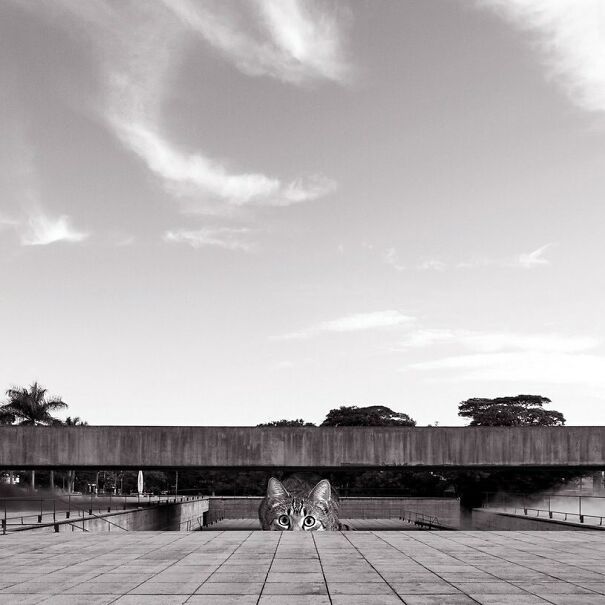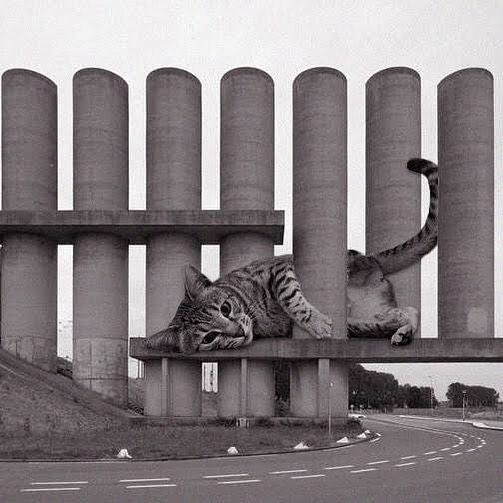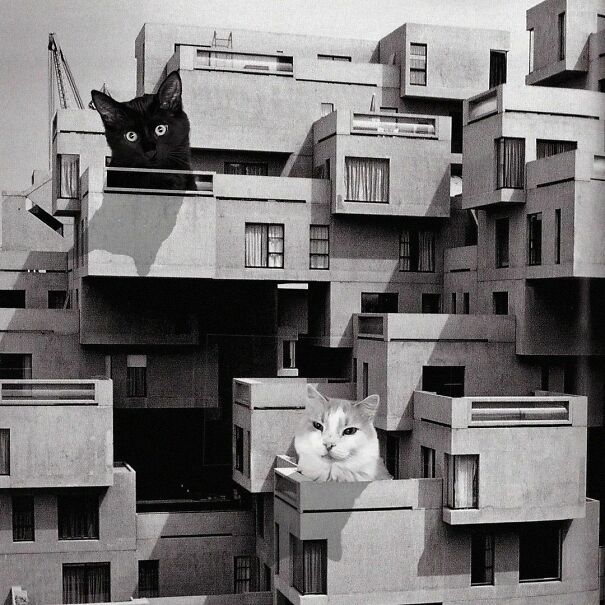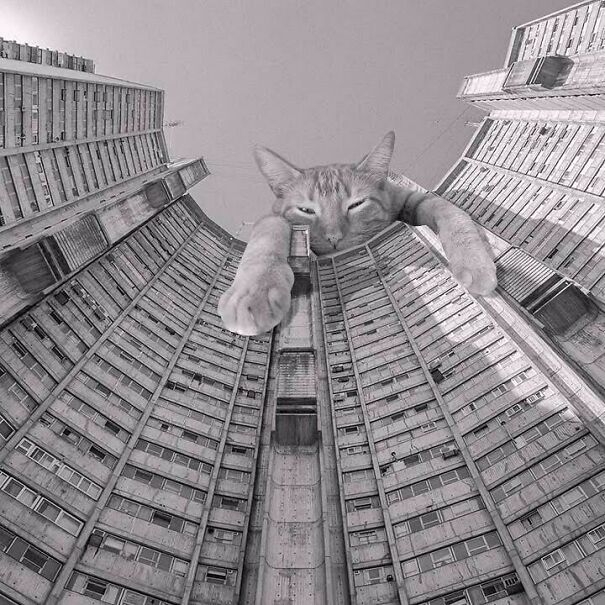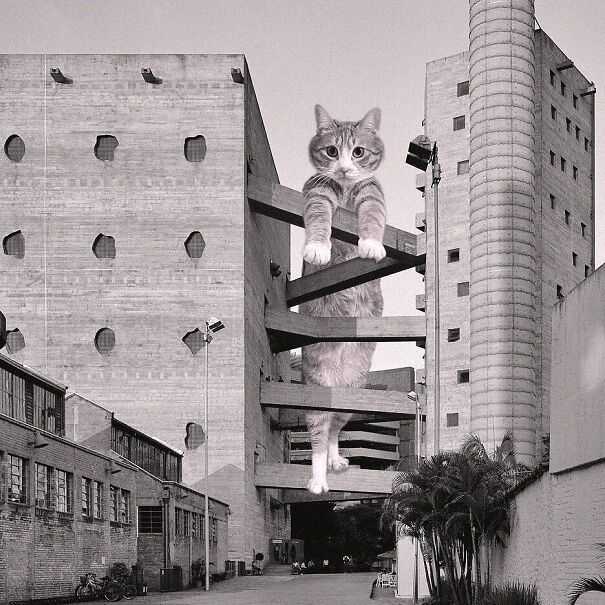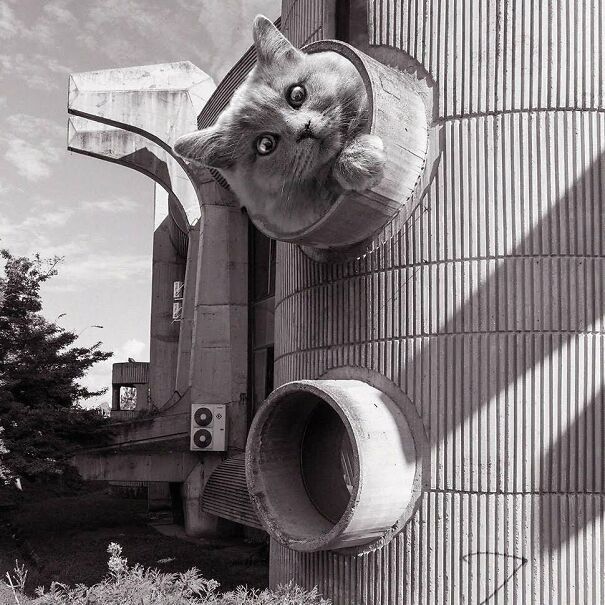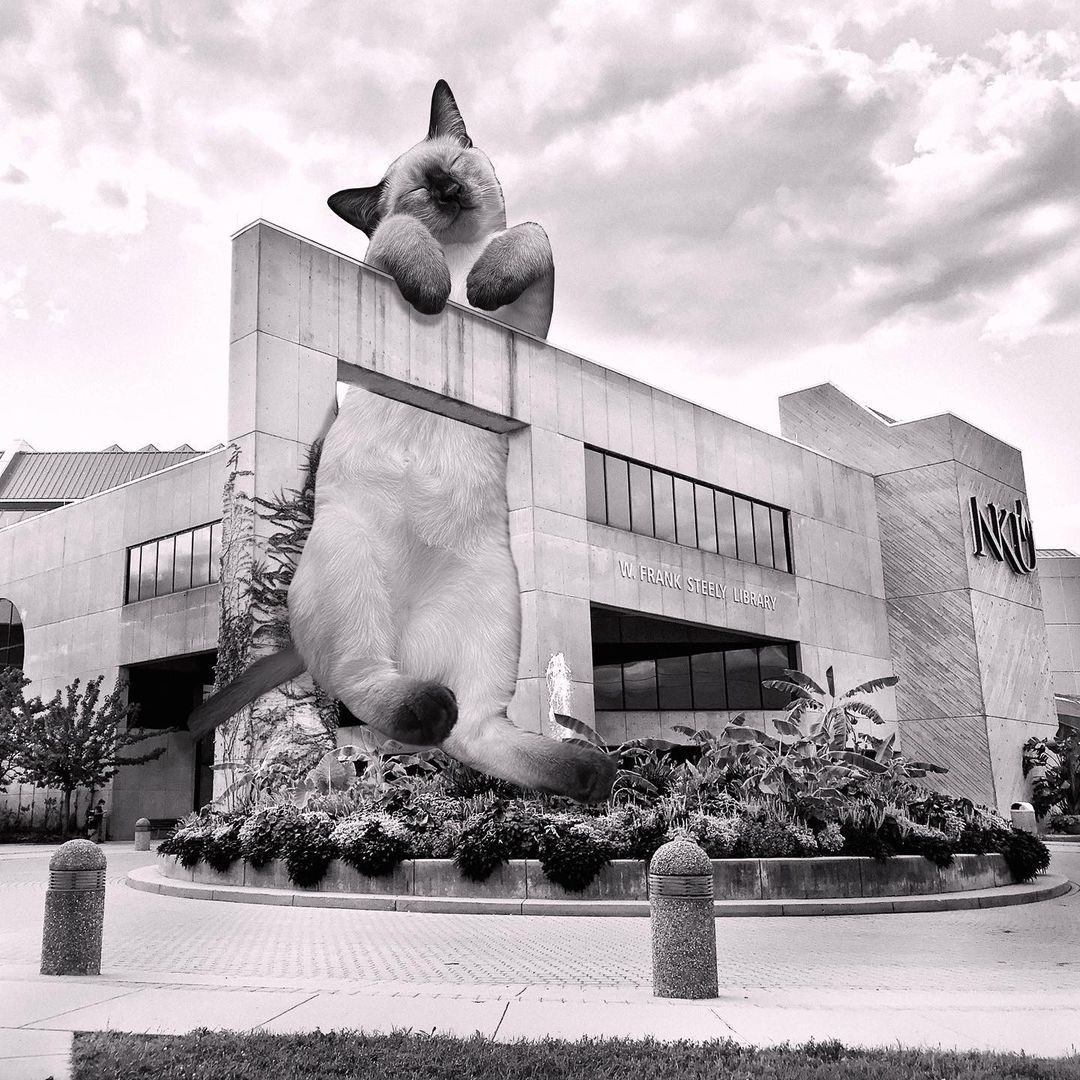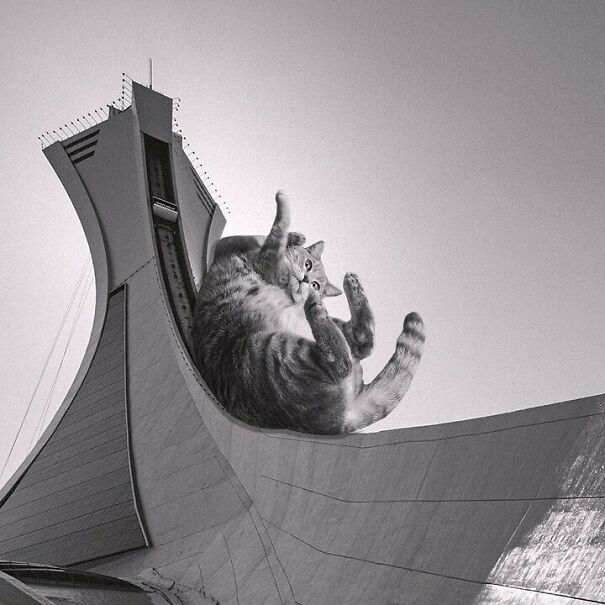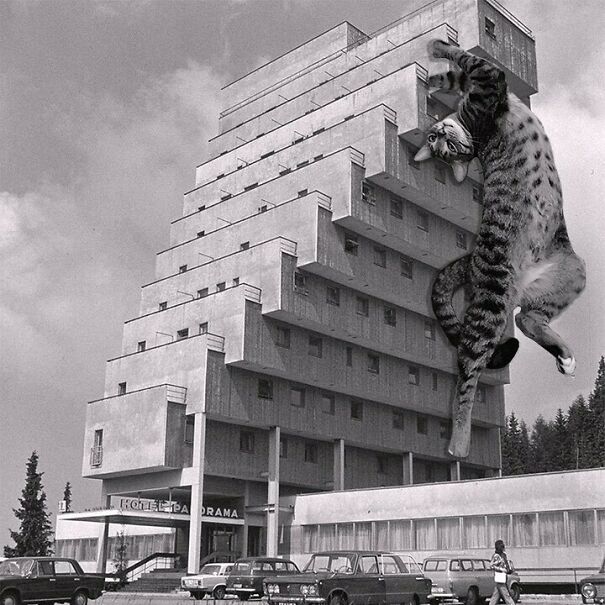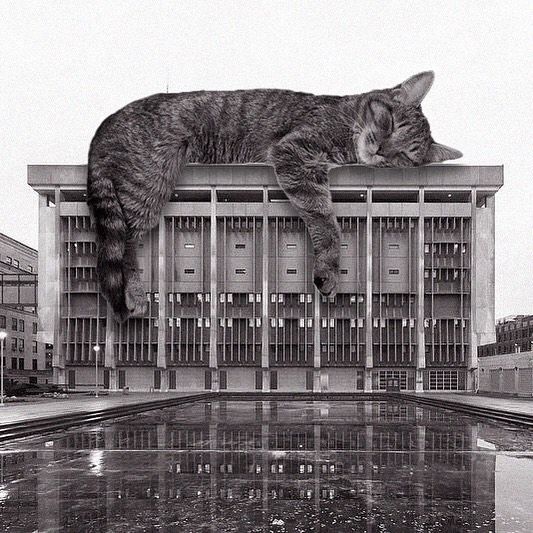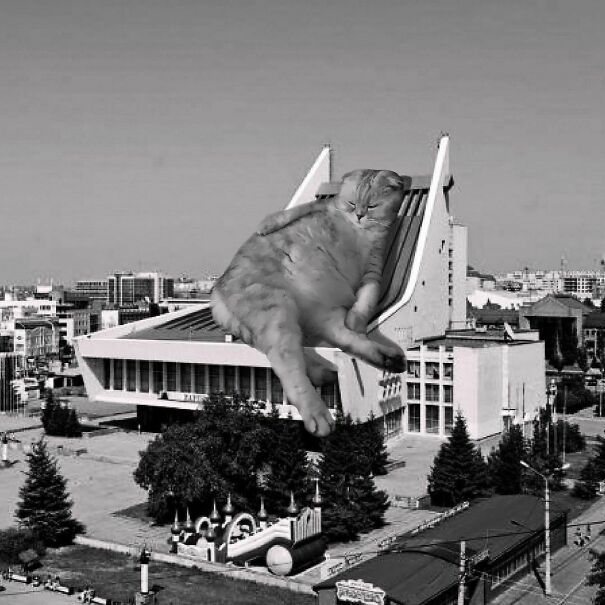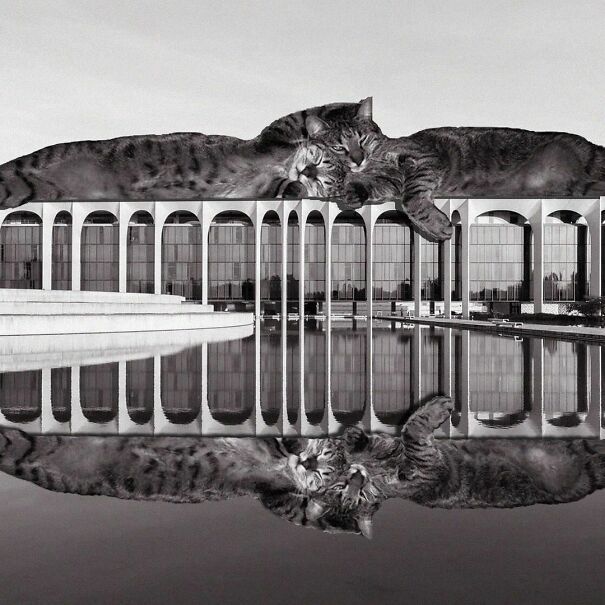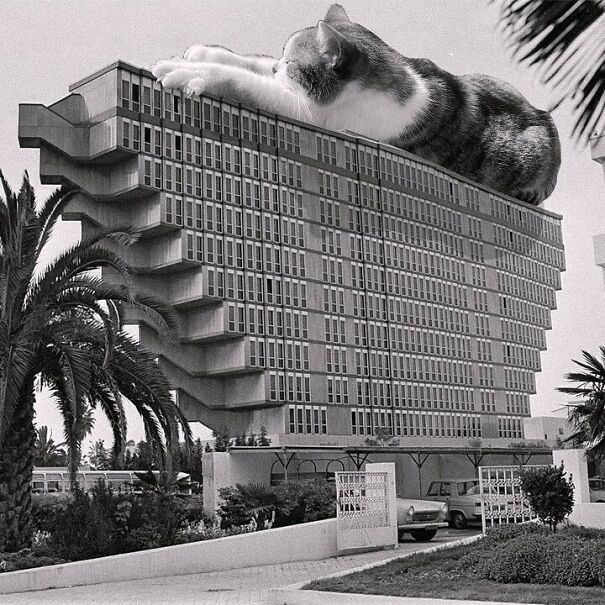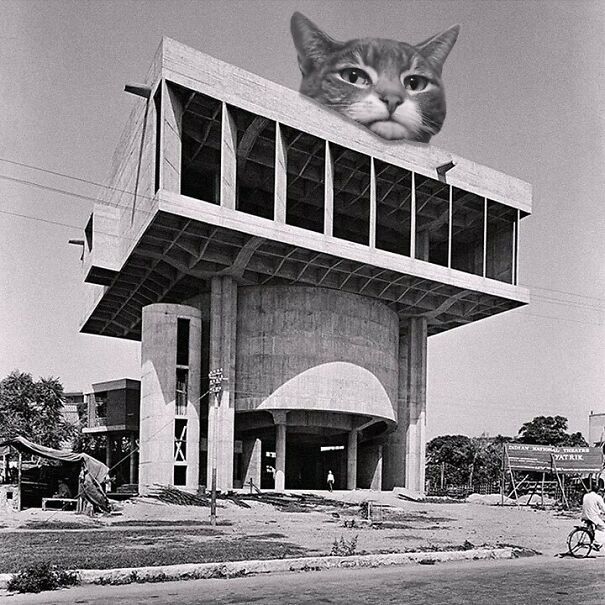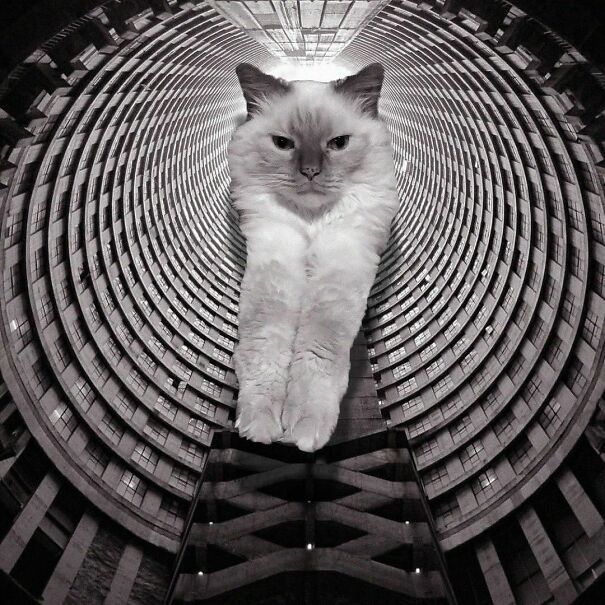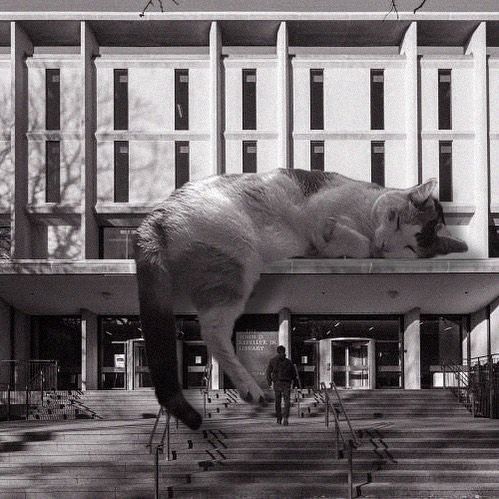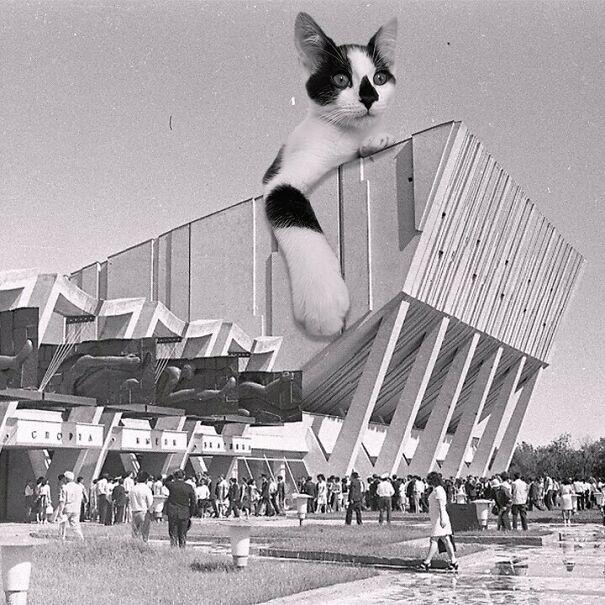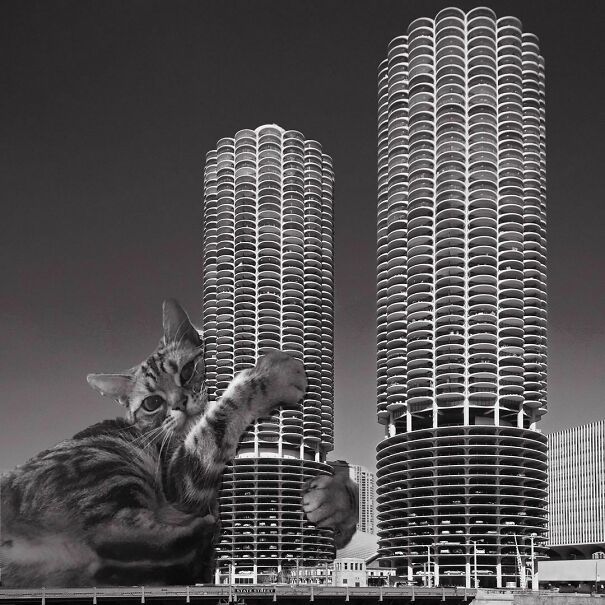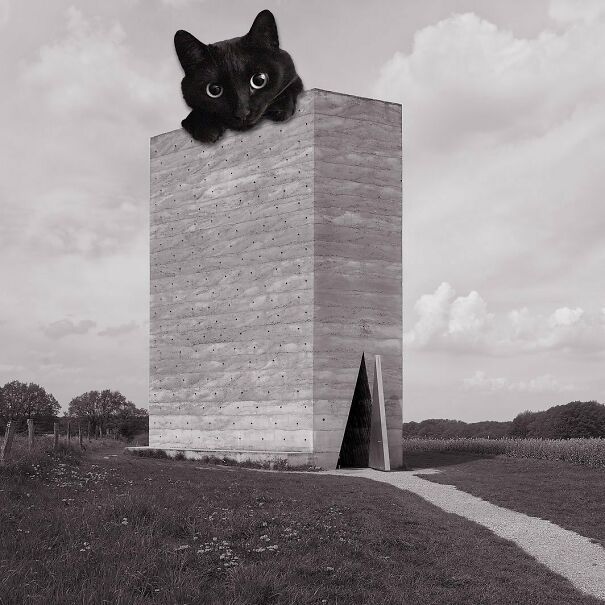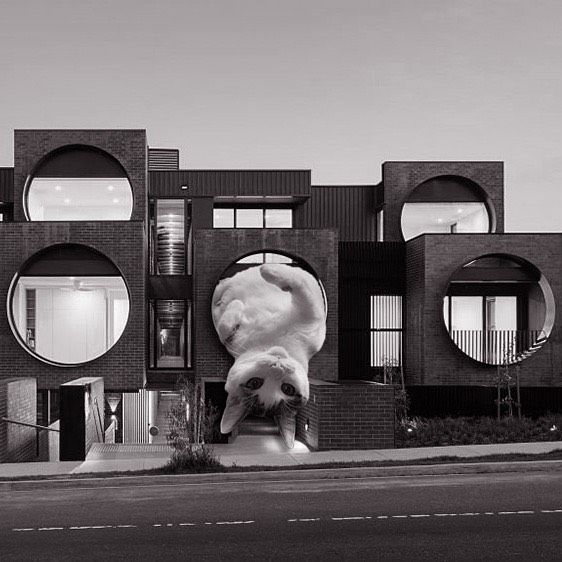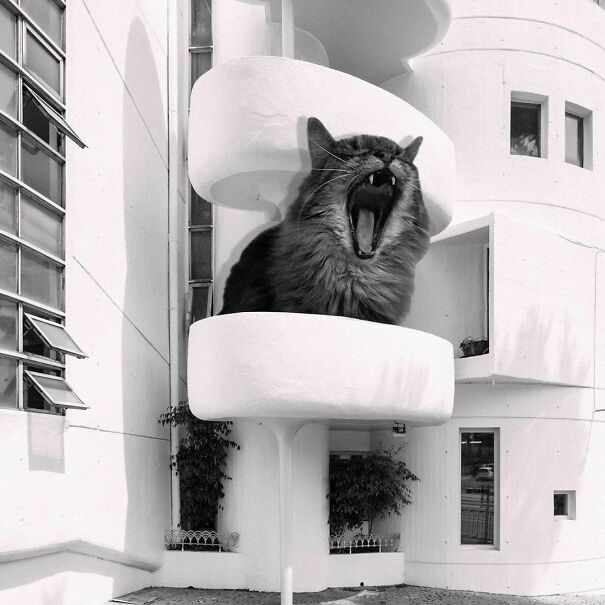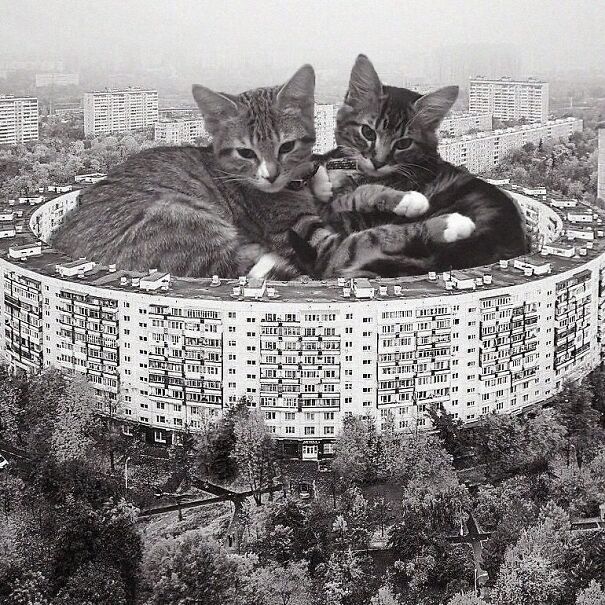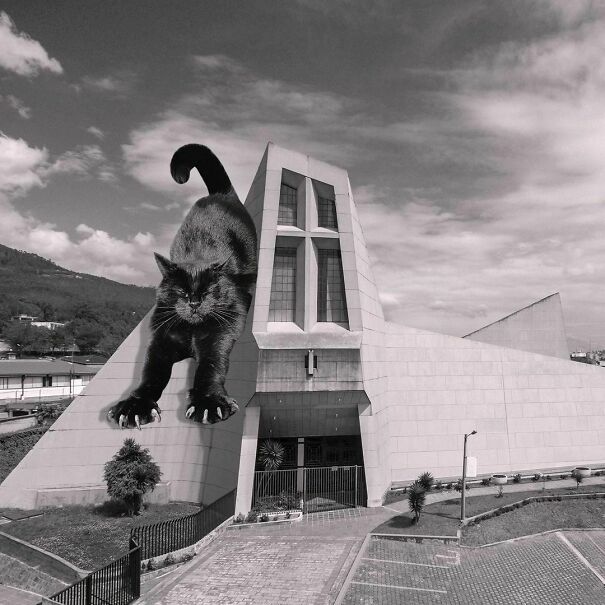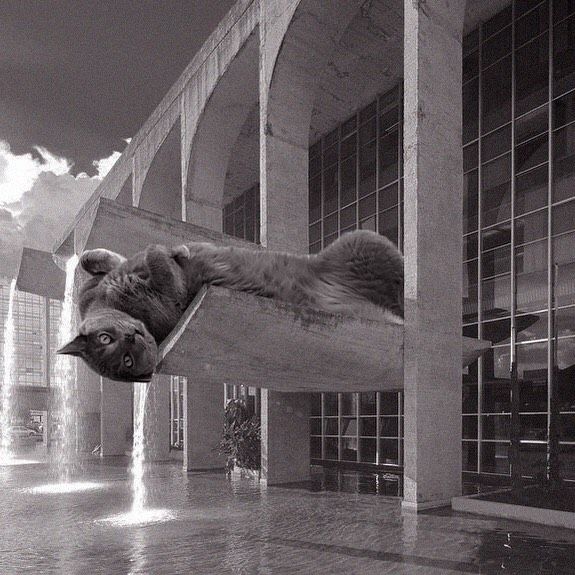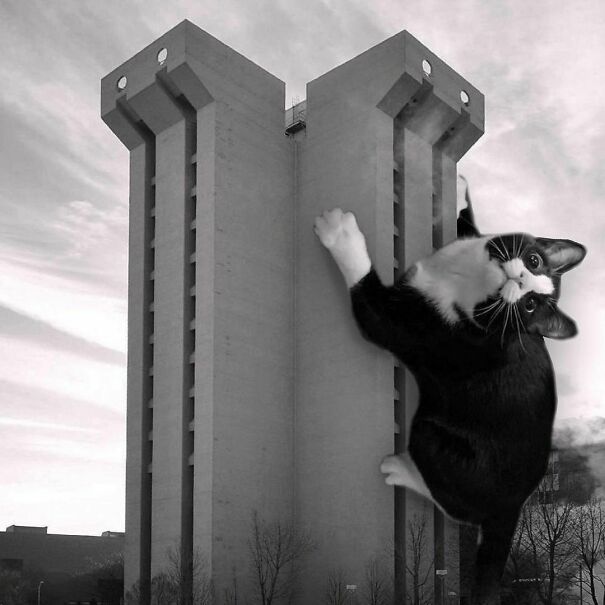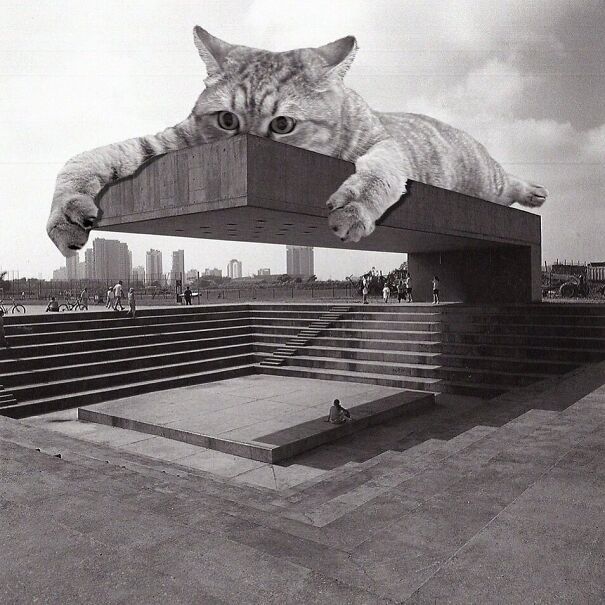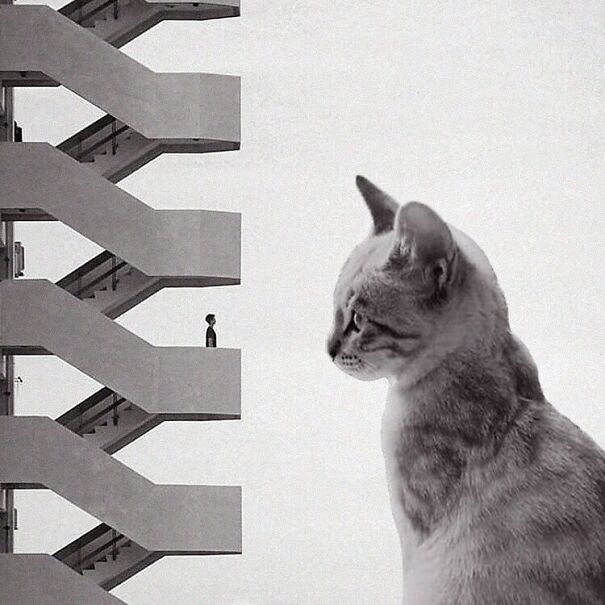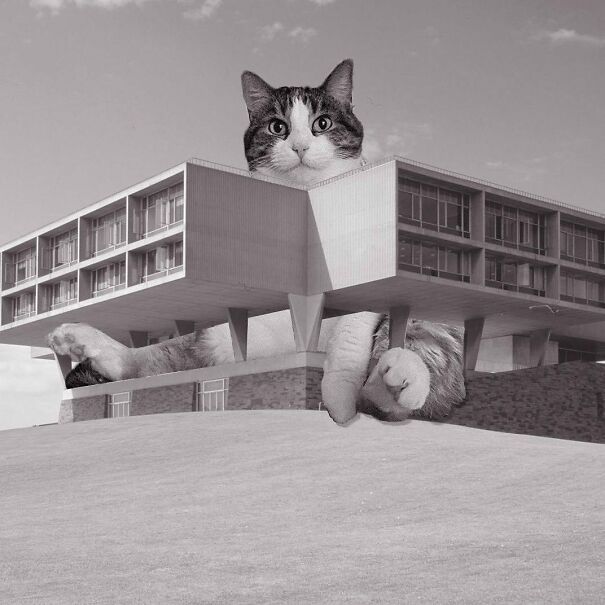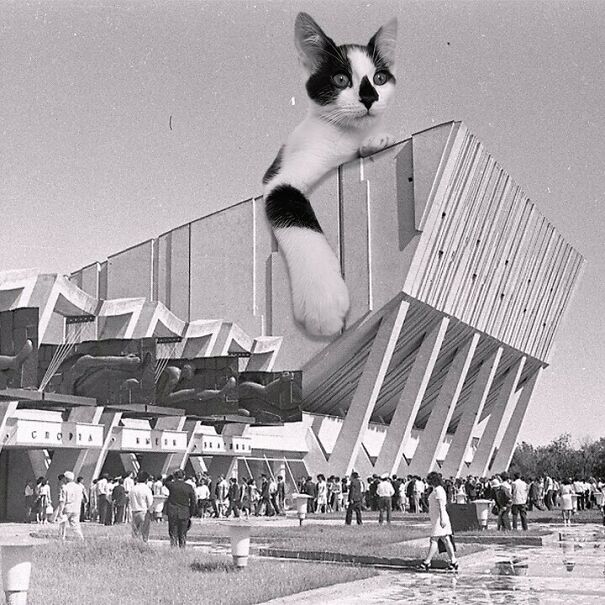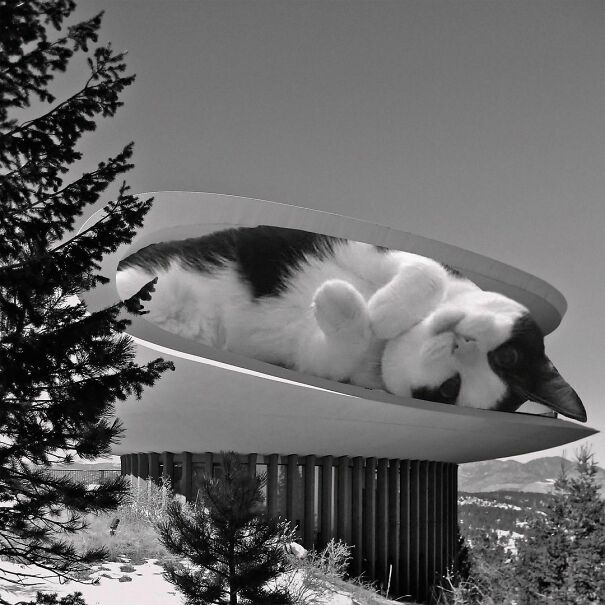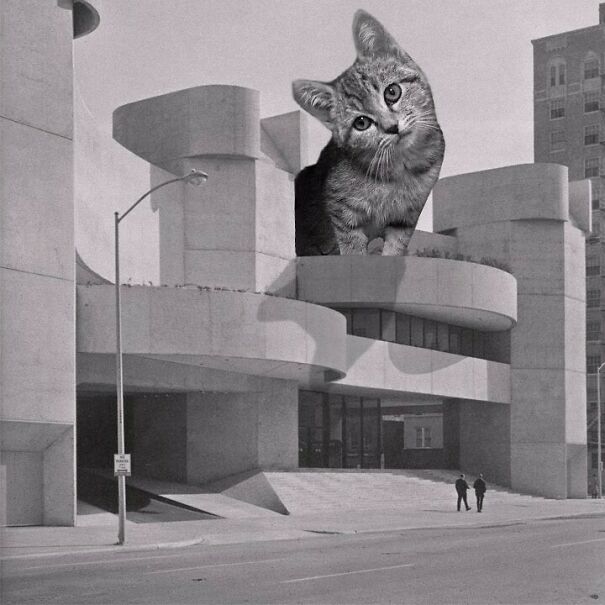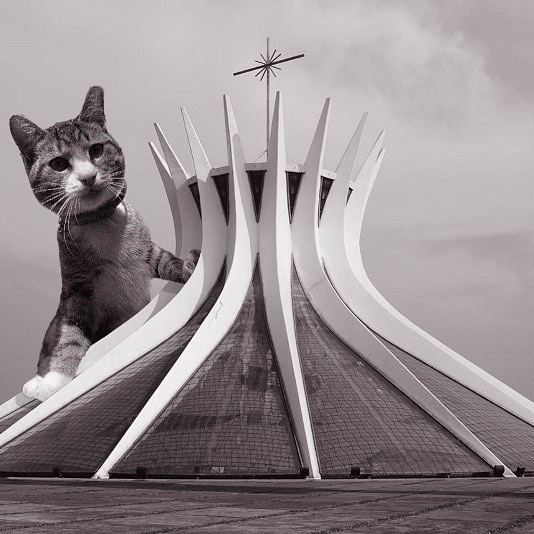Cats make everything extra adorable, don’t they? Even massive, rigid, brutalist architecture! “If It Fits, I Sits” is basically the motto of every cat—three artists thought of this motto beyond tiny boxes and shoes, to explore what would happen if cats became too giant or if cities shrunk.
“Cats of Brutalism” is a series of black and white digital pictures of some famous brutalist architecture invaded by giant cats around the world. Some artists actually enjoy combining architecture with animals, check these ink architectural sketches of famous architecture and animals combined in a “magical-realistic” way.
This project is curated by three post-graduate students at the Master of Architecture program at the University of Buffalo. Emily Battaglia, Madelaine Ong, and Michaela Senay made an Instagram account dedicated to “daily doses of cats and concrete,” At first, the mix doesn’t seem like something that would attract 104k followers. However, the rough lines and rigidness of brutalist architecture combined with the cuteness and softness of our furry friends make really funny and addictive pictures.
“We never imagined this project would reach the audience it has. Our goal originally was to reach an audience of about 1,500 in 3 months to be able to call it successful. By 3 months, we were close to 20 thousand. The response has been very positive as well. We have received a lot of appraisal and support, which is what motivates us to post daily.”
-Said Emily Battaglia in an interview with Bored Panda
30 Pictures of Brutalist Architecture Made Adorable by Giant Cats
1. Textile Centre; Chee Soon Wah, 1974, Kallang, Singapore
2. Central Post Office; Janko Konstantinov, 1982, Skopje, Macedonia
3. “Musical Island”, Villa-Lobos State Park; Decio Tozzi, 1989, São Paulo, Brazil
4. Milwaukee Police Administration Building; 1971, Milwaukee, Wisconsin
5. Palácio Da Justiça; Oscar Niemeyer, 1962, Brasilia, Brazil
6. Mondadori Group Headquarters; Oscar Niemeyer, 1975, Milan, Italy
7. Omsk Musical Theatre; Lurie, Strigun And Belousova, 1981, Omsk Oblast, Russia
8. The Rock, Brown University Library; Warner, Burns, Toan & Lunde, 1964, Providence, Rhode Island
9. Dr. Seo’s Women’s Clinic Building (Atrium Office Building); Chung-Up Kim, 1967, Seoul, Korea
10. Montreal Olympic Stadium; Roger Taillibert, 1976, Montreal, Canada
Regarding the idea behind combining cats with brutalist architecture, Michaela Senay said that their “initial goal was to create an Instagram page that could promote the preservation of brutalism and the style of brutalist architecture as a whole. We wanted to be able to differentiate ourselves from other architectural pages.”
There is controversy surrounding the discussion on whether or not brutalism is worth preserving and rather than being politically driven, we thought adding humor, such as the photoshopping of cats, could still be used to promote brutalism in a fun and light-hearted way.
11. Sesc Pompéia; Lina Bo Bardi, 1982, São Paulo, Brazil
12. “Bublik” Apartment Complex; Eugene Stamo, 1972, Moscow, Russia
13. Cirqua Apartments; BKK Architects, 2017, Melbourne, Australia
14. Rozenburg Wind Wall; Maarten Struijs, 1985, Rozenburg, Netherlands
15. Shri Ram Center For Art And Culture; Shiv Nath Prasad & Mahendra Raj, 1969, New Delhi, India
16. Marina City; Bertrand Goldberg, 1964-68, Chicago, Illinois
17. Milwaukee County War Memorial Center; Eero Saarinen, 1957, Milwaukee, Wisconsin
18. Kojomkul Sports Palace; V. Kostin And V. Marukov, 1974, Bishkek, Kyrgyzstan
19. Torre Dorrego; Luis T. Caffarini, Alfredo Joselevich, & Alberto Ricur, 1968 – 1970, Buenos Aires, Argentina
20. Bruder-Klaus Field Chapel; Peter Zumthor, 2007, Mechernich, Germany
“The goal of the project was to create discussion on brutalist structures, as we recognized brutalism as an under-represented and under-appreciated architecture style. We believed the two contrasting subjects, super-scaled cats playing/interacting with it, can bring two communities together, cat lovers and architecture lovers, to educate and genuinely entertain viewers.”
-Said Emily Battaglia
Madelaine seconds the other creators, saying that brutalism is under-appreciated, and shares what they like about it the most. She said that they chose brutalist architecture because it was “recognized as an architectural style that is under-represented and under-appreciated globally.”
She added that “since brutalism has multiple textures, ranging from monolithic ‘blocky’ appearances to ‘corduroy’ textured concrete, we believed it would be the perfect pairing for super-scaled cats to experience these forms as play objects that cats would love to play on, perch on, lay on, climb on, and scratch on.”
“We began experimenting with cats up for adoption and brutalist buildings in need of attention, bridging two subjects that need awareness. We like that brutalist architecture has versatility when it comes to its design and can be found as a neighboring style in one’s country.”
21. Ponte City Apartments; Manfred Hermer, 1975, Johannesburg, South Africa
22. Hotel Panorama Resort; Zdeněk Řihák, 1969, Štrbské Pleso, Slovakia
23. Crosley Tower, University At Cincinnati; A.M. Kinney Associates, 1969, Cincinnati, Ohio
24. Deaton Sculptured House; Charles Deaton, 1963, Genesee, Colorado
25. Habitat 67; Moshe Safdie, 1967, Montreal, Quebec
26. Hôtel Du Lac; Raffaele Contigiani, 1973,tunis, Tunisia
27. Templo De La Dolorosa; Milton Barragán Dumet, 1978, Quito, Ecuador
28. Mube (Museu Brasileiro Da Escultura E Ecologia); Paulo Mendes Da Rocha, 1995, São Paulo, Brazil
29. The Alley Theatre; Ulrich Franzen, 1968, Houston, Texas
30. Cathedral Of Brasilia; Oscar Niemeyer, 1970, Brasilia, Brazil
When asked about what challenged them the most and what motivated them to keep going on their project adding cute giant cats to miniature brutalist architecture, the team seemed pretty passionate about it. Madelaine said that “the most challenging thing about our project would be finding a good pairing between cat and building to create a post. Sometimes, we’d research a building but find the cat we’d like to pair with it doesn’t end up matching the building as we thought it would and vice versa.”
On the other hand, she thought that the most rewarding thing was “the immense support we’ve received from fans and newspaper platforms in different parts of the world. We never thought our project would have exploded the way it did and are appreciative towards the growing community it has formed each day.”
